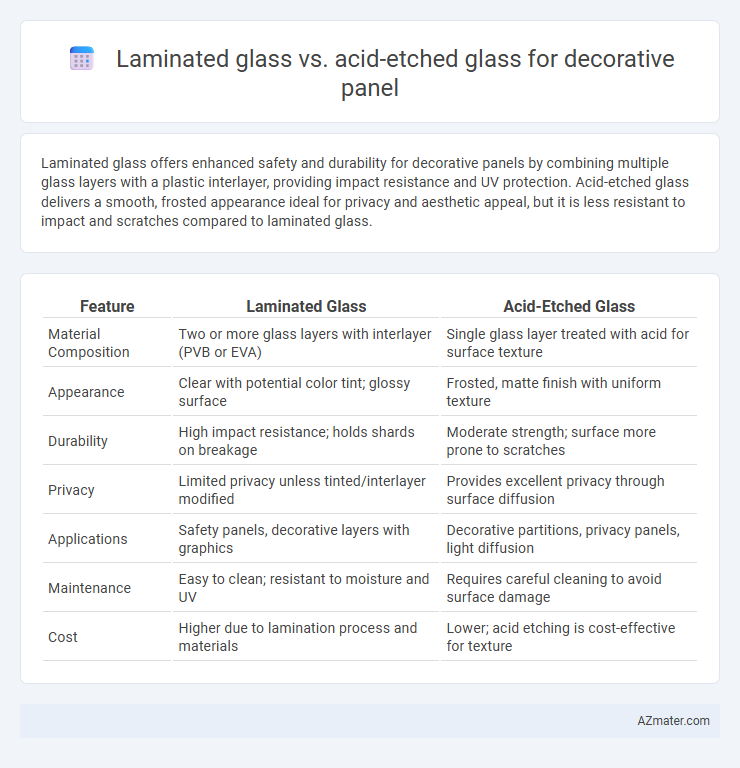Laminated glass offers enhanced safety and durability for decorative panels by combining multiple glass layers with a plastic interlayer, providing impact resistance and UV protection. Acid-etched glass delivers a smooth, frosted appearance ideal for privacy and aesthetic appeal, but it is less resistant to impact and scratches compared to laminated glass.
Table of Comparison
| Feature | Laminated Glass | Acid-Etched Glass |
|---|---|---|
| Material Composition | Two or more glass layers with interlayer (PVB or EVA) | Single glass layer treated with acid for surface texture |
| Appearance | Clear with potential color tint; glossy surface | Frosted, matte finish with uniform texture |
| Durability | High impact resistance; holds shards on breakage | Moderate strength; surface more prone to scratches |
| Privacy | Limited privacy unless tinted/interlayer modified | Provides excellent privacy through surface diffusion |
| Applications | Safety panels, decorative layers with graphics | Decorative partitions, privacy panels, light diffusion |
| Maintenance | Easy to clean; resistant to moisture and UV | Requires careful cleaning to avoid surface damage |
| Cost | Higher due to lamination process and materials | Lower; acid etching is cost-effective for texture |
Introduction to Decorative Glass Panels
Decorative glass panels enhance interior design by combining aesthetics with functionality, using materials such as laminated glass and acid-etched glass. Laminated glass offers safety and sound insulation through a plastic interlayer while maintaining clear or customized decorative patterns. Acid-etched glass provides a frosted, translucent effect that adds privacy and texture without compromising light transmission.
What is Laminated Glass?
Laminated glass consists of two or more glass layers bonded with an interlayer, typically polyvinyl butyral (PVB), offering enhanced safety and impact resistance for decorative panels. Its structure retains glass shards within the interlayer upon breakage, reducing injury risk and providing sound insulation and UV protection. Frequently used in architectural applications, laminated glass combines aesthetics with durability and safety for interior and exterior decorative purposes.
What is Acid-Etched Glass?
Acid-etched glass is a type of decorative glass created by treating the surface with acid to produce a smooth, frosted appearance that diffuses light while maintaining privacy. Unlike laminated glass, which fuses multiple layers for safety and durability, acid-etched glass offers aesthetic enhancement with a matte finish but lacks impact resistance. This makes acid-etched glass ideal for decorative panels where light diffusion and subtle elegance are prioritized over protective features.
Aesthetic Appeal: Laminated vs Acid-Etched Glass
Laminated glass offers a sleek, glossy finish with enhanced depth and clarity, making it a popular choice for decorative panels where both aesthetics and safety are prioritized. Acid-etched glass provides a frosted, matte surface that diffuses light softly, creating an elegant, muted look ideal for privacy and subtle design elements. The choice between laminated and acid-etched glass depends on desired visual impact: laminated glass emphasizes vibrant transparency, whereas acid-etched glass highlights texture and softness in decorative applications.
Strength and Durability Comparison
Laminated glass offers superior strength and durability due to its multiple layers bonded with a resilient interlayer that holds shards in place upon impact, making it highly resistant to breakage and suitable for safety-critical decorative panels. Acid-etched glass, while providing elegant matte finishes, is more prone to surface scratches and chips, resulting in reduced durability under heavy use or impact. For long-lasting decorative panels requiring enhanced protection and structural integrity, laminated glass is the preferred choice over acid-etched glass.
Safety and Security Features
Laminated glass offers superior safety and security for decorative panels by retaining shards upon impact due to its interlayer, reducing injury risks and deterring break-ins. Acid-etched glass, while providing aesthetic appeal with frosted surfaces, lacks impact resistance and shatters more easily under force, posing higher safety concerns. Choosing laminated glass enhances protection against accidents and intrusions while maintaining decorative qualities.
Privacy Options and Light Diffusion
Laminated glass offers enhanced privacy through its ability to incorporate opaque or frosted interlayers while maintaining strong light diffusion, making it ideal for decorative panels requiring both security and gentle illumination. Acid-etched glass provides uniform, translucent surfaces that diffuse light softly but offer moderate privacy, suitable for aesthetic applications where subtle obscuration is sufficient. Choosing between laminated and acid-etched glass depends on the desired balance between privacy levels and the quality of light diffusion in the decorative panel design.
Maintenance and Cleaning Considerations
Laminated glass features a durable interlayer that resists scratches and reduces the need for frequent cleaning, making it low-maintenance and easy to clean with standard glass cleaners. Acid-etched glass has a porous surface that can attract dust and dirt, requiring gentle cleaning with non-abrasive cloths and mild solutions to avoid surface damage. Maintenance for acid-etched glass involves periodic deep cleaning to preserve its decorative matte finish, while laminated glass maintains clarity and aesthetics with minimal effort.
Cost Analysis: Laminated vs Acid-Etched Panels
Laminated glass panels typically incur higher costs due to multi-layer construction and enhanced safety features, with prices ranging from $25 to $50 per square foot depending on thickness and interlayer materials. Acid-etched glass offers a more cost-effective option, generally priced between $15 and $35 per square foot, influenced by the complexity of the etching pattern and glass quality. When selecting decorative panels, budget considerations often favor acid-etched glass for large-scale projects, while laminated glass investments target durability and safety requirements.
Choosing the Right Glass for Decorative Panels
Laminated glass offers superior safety and sound insulation by combining two or more glass layers with an interlayer, making it ideal for decorative panels requiring durability and impact resistance. Acid-etched glass provides a smooth, frosted finish that enhances privacy and aesthetics without compromising natural light, perfect for decorative panels emphasizing elegant design and subtle translucency. Choosing between laminated and acid-etched glass depends on whether safety and strength or visual texture and privacy are the primary priorities for the decorative application.

Infographic: Laminated glass vs Acid-etched glass for Decorative panel
 azmater.com
azmater.com